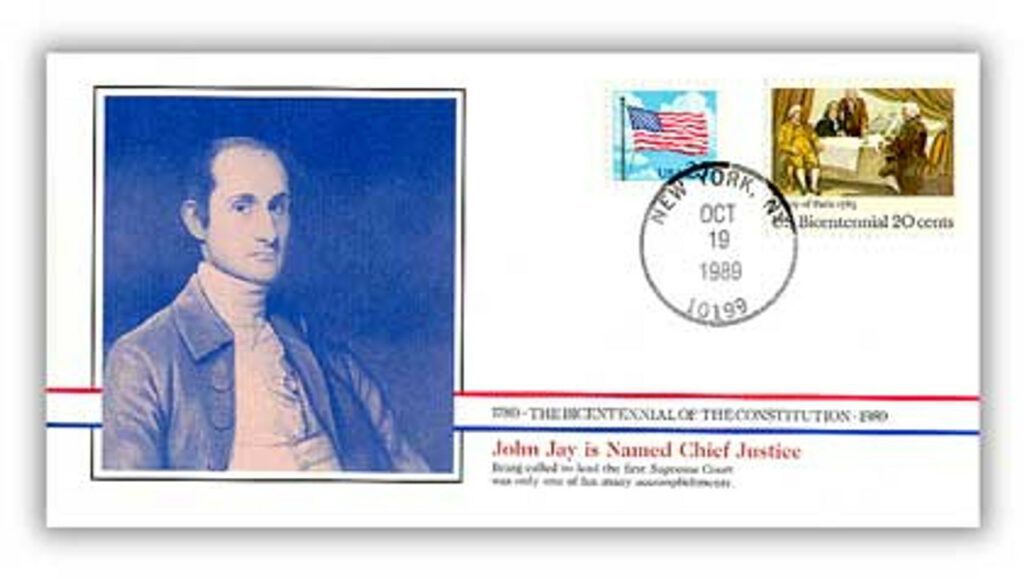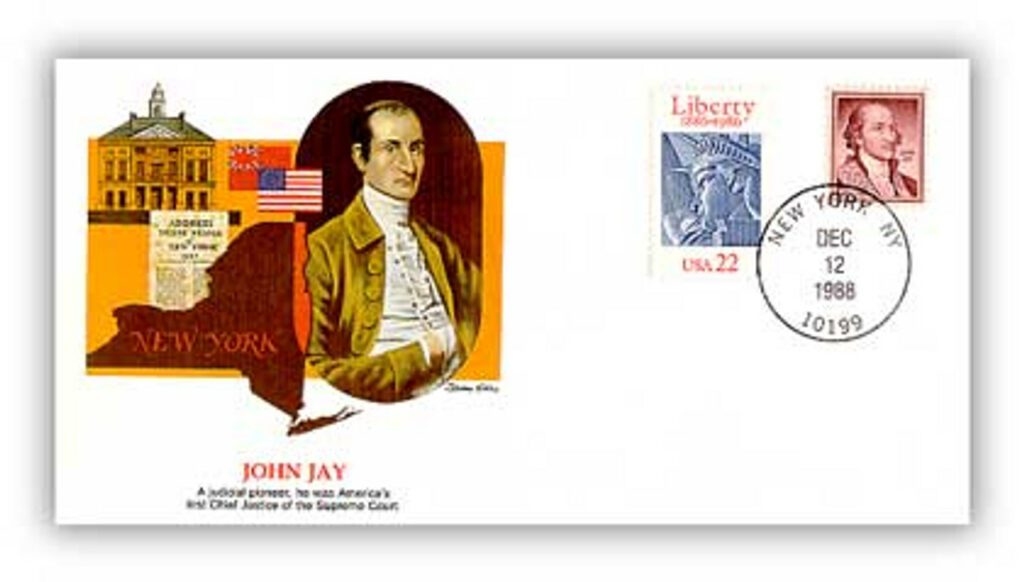
On October 19, 1789, John Jay was sworn in as America’s first Chief Justice of the Supreme Court.
John Jay was one of America’s Founding Fathers, serving in the First and Second Continental Congress, drafting New York’s Constitution, and serving as New York’s Chief Justice of the Supreme Court of Judicature. He was also American Ambassador to Spain, Secretary of Foreign Affairs, and helped negotiate the Treaty of the Paris, in which Great Britain recognized America’s independence. Supporting a strong centralized government, Jay helped write the Federalist Papers with Alexander Hamilton and James Madison, which promoted the ratification of the U.S. Constitution.
After the Constitution was ratified, President Washington needed to make several political appointments. In September 1789, he offered Jay the position of Secretary of State. Though a new title, it would’ve been the same duties he was already performing as Secretary of Foreign Affairs. Jay turned down the offer, but Washington had another in mind – Chief Justice of the Supreme Court. According to Washington, the position “must be regarded as the keystone of our political fabric.” After Jay accepted, Washington officially nominated him on September 24, and the Senate unanimously confirmed him two days later. Jay swore his oath of office on October 19.
For the first three years, most of the Supreme Court’s time was spent establishing rules and procedures, admitting attorneys to the bar, and overseeing circuit court cases in the federal judicial districts. In his spare time, Jay aided President Washington and spread his ideas while touring the circuit courts.

In 1790, Jay established the court’s independence after Treasury Secretary Alexander Hamilton asked the court to support legislation over state debts. Jay said that the court could only rule on the constitutionality of cases being tried and wouldn’t take a position for or against the legislation.
In the six years Jay was Chief Justice, the Supreme Court only heard four cases. In the first case, they sided with state statute requirements. The second case concerned whether a federal statute could require the court to decide if war veterans qualified for pensions. The court initially decided to continue the case at a later time, but Congress changed the law in the interim. After this, the court wrote that it was a violation of the separation of powers for the legislature and executive branch to revise the court’s ruling. The third case asked if “the state of Georgia [was] subject to the jurisdiction of the Supreme Court and the federal government.” Though the court ruled in favor of South Carolina loyalists whose land was seized by Georgia, their decision was later overturned by the 11th Amendment. In their final case, the court decided that jurors should make their decisions based both on fact and law, as some had previously questioned if it was in their power to decide the law.
Click the images to add this history to your collection.


Great article
Love these daily bits of history. Thanks for sending.
Seems like a very important person in the early times.
If no one brings the facts to surface they remain submerged. Thanks for your effort.
My daughter is using these posts as a basis for history lessons for her home-schooled kids. A side effect will be the introduction of two more kids into stamp collecting.
Always enjoy reading the History of the Day
I look forward to your email every day.
Nice story
And today’s Chief Justices are ruling on much more than a laws Constitutionality, but writing law themselves by denying Tenth Amendment states rights, as in the definition of marriage, abortion, etc.
Another interesting part of our History with stamps to enhance
that part of our History…I have been sending The Day to my
16 year old granddaughter and she tells me she is becoming more
interested in our history and wow!!!!….. likes the stamp info……. !!!!
In Dave’s comment (above), he above might want to look up Article VI of the U.S. Constitution which states in part, “This Constitution and the laws of the United States…shall be the supreme law of the land and the judges in every state shall be bound thereby, any thing in the constitutions or laws of any state to the contrary notwithstanding .”
When you look at the George Washington administration you realize that through his appointments and constituency our 1st president surrounded himself with what truly was the dream team. The article is about John Jay and mentions Alexander Hamilton, but the balance of the group known as “The Framers”(Jefferson, Madison, Monroe, Franklin et al) were all on board and would emerge individually as well.
Just a humorous observation from the former copy editor of his high school newspaper. In the last paragraph, you state, “The second case concerned whether a federal statue could require the court to decide if war veterans qualified for pensions.”
The missing “t” in “statue” is obvious; but it still makes for a hilarious copy error [as many copy errors do]. To think that a statue could influence the Supreme Court of the U.S.!
Sorry to nit pick. Your daily emails are much appreciated and well done.
October 19, 1781 British General Cornwallis surrendered his command to
the Continental Army effectively ending the Revolutionary War. His surrender
was the final act and the British Parliament had enough of the war. Less than two
years later the Treaty of Paris gave the Colonies their independence.
The most important case John Jay wrote as Chief Justice was Marburg v Madison. This established the Supreme Court’s ability to strike down actions and laws deemed to be unconstitutional setting the powers of the Supreme Court foe the next 200+ years
Marbury v Madison
Yes, Lord Cornwallis surrendered in Yorktown, Virginia. To Mr Richard
Messersmith. If I’m not mistaken, there was a German WWII fighter BF 262.
These fighter (aircraft) was the first jet fighter ever built. It is the prototype of all future fighters, from the Mig (Migoyan Gurevich), to the F16, F18, etc.